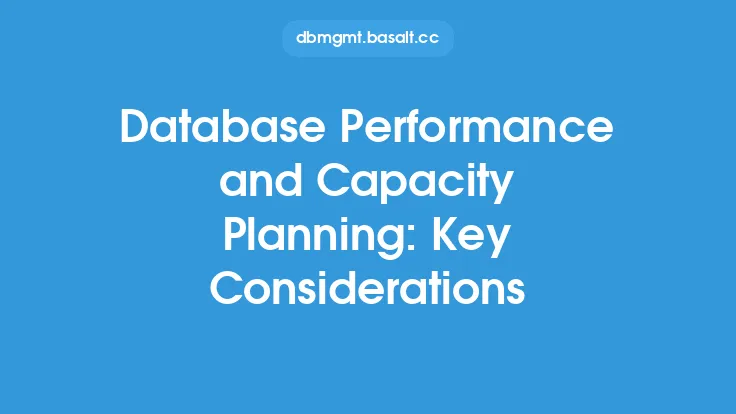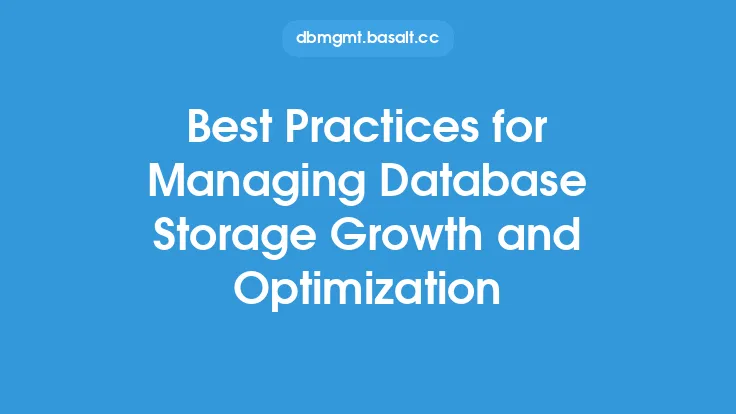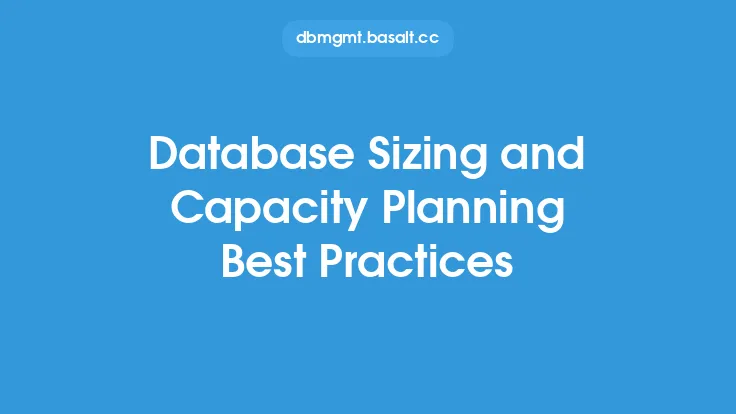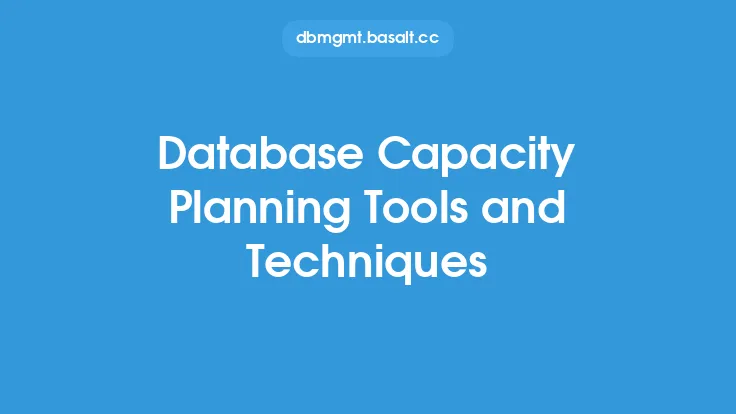When it comes to designing and managing databases, one of the most critical aspects to consider is capacity planning. This involves anticipating and preparing for the growth and scalability of the database, ensuring that it can handle increasing amounts of data and user traffic without compromising performance. Effective capacity planning is essential for maintaining the reliability, efficiency, and overall health of the database, and it requires a deep understanding of the database's architecture, workload, and usage patterns.
Introduction to Database Capacity Planning
Database capacity planning is a systematic process that involves analyzing the current and future needs of the database, identifying potential bottlenecks and areas of concern, and developing strategies to address them. It requires a thorough understanding of the database's hardware and software components, as well as the applications and services that rely on it. By planning for capacity, database administrators can ensure that the database is able to handle increased traffic, data growth, and changing user demands, while also minimizing downtime, improving performance, and reducing costs.
Understanding Database Workloads
To develop an effective capacity planning strategy, it's essential to understand the database workload. This includes analyzing the types of queries being executed, the frequency and volume of transactions, and the data access patterns. Database workloads can be broadly categorized into several types, including online transaction processing (OLTP), online analytical processing (OLAP), and data warehousing. Each of these workloads has unique characteristics and requirements, and understanding these differences is critical for developing a capacity planning strategy that meets the needs of the database.
Database Architecture and Scalability
The database architecture plays a critical role in determining its scalability and capacity. A well-designed database architecture should be able to handle increasing amounts of data and user traffic without compromising performance. This can be achieved through a variety of techniques, including horizontal partitioning, vertical partitioning, and data replication. Horizontal partitioning involves dividing the data into smaller, more manageable chunks, while vertical partitioning involves separating the data into different tables or indexes. Data replication involves duplicating the data across multiple servers to improve availability and performance.
Capacity Planning Metrics and Benchmarks
To develop an effective capacity planning strategy, it's essential to establish metrics and benchmarks that can be used to measure the database's performance and capacity. These metrics can include factors such as query execution time, transaction throughput, and disk usage. By establishing baseline metrics and benchmarks, database administrators can identify areas of concern and develop strategies to address them. Some common capacity planning metrics and benchmarks include:
- Query execution time: This measures the time it takes for the database to execute a query.
- Transaction throughput: This measures the number of transactions that the database can handle per unit of time.
- Disk usage: This measures the amount of disk space used by the database.
- CPU usage: This measures the amount of CPU resources used by the database.
- Memory usage: This measures the amount of memory used by the database.
Database Sizing and Capacity Planning
Database sizing and capacity planning involve determining the optimal size and configuration of the database to meet the needs of the application and users. This requires analyzing the database workload, identifying potential bottlenecks and areas of concern, and developing strategies to address them. Some common techniques used in database sizing and capacity planning include:
- Capacity modeling: This involves creating a mathematical model of the database workload and using it to predict future capacity requirements.
- What-if analysis: This involves analyzing the impact of different scenarios and variables on the database's performance and capacity.
- Benchmarking: This involves comparing the database's performance and capacity to established benchmarks and standards.
Best Practices for Database Capacity Planning
To develop an effective capacity planning strategy, it's essential to follow best practices that have been established through experience and research. Some common best practices for database capacity planning include:
- Monitor database performance and capacity regularly: This involves tracking key metrics and benchmarks to identify areas of concern and develop strategies to address them.
- Analyze database workloads and usage patterns: This involves understanding the types of queries being executed, the frequency and volume of transactions, and the data access patterns.
- Develop a capacity planning strategy: This involves identifying potential bottlenecks and areas of concern, and developing strategies to address them.
- Test and validate capacity planning assumptions: This involves testing and validating the assumptions and predictions made during the capacity planning process.
- Continuously review and update the capacity planning strategy: This involves regularly reviewing and updating the capacity planning strategy to ensure that it remains effective and relevant.
Common Challenges and Pitfalls
Despite the importance of capacity planning, many organizations face challenges and pitfalls when trying to develop an effective strategy. Some common challenges and pitfalls include:
- Lack of understanding of the database workload and usage patterns: This can make it difficult to develop an effective capacity planning strategy.
- Insufficient resources and budget: This can limit the ability to implement effective capacity planning strategies.
- Inadequate monitoring and analysis: This can make it difficult to identify areas of concern and develop strategies to address them.
- Inability to predict future growth and demand: This can make it difficult to develop an effective capacity planning strategy that meets the needs of the database and users.
Conclusion
In conclusion, capacity planning is a critical aspect of database design and management that requires a deep understanding of the database's architecture, workload, and usage patterns. By following best practices, monitoring performance and capacity, and analyzing database workloads and usage patterns, database administrators can develop an effective capacity planning strategy that meets the needs of the database and users. This involves identifying potential bottlenecks and areas of concern, developing strategies to address them, and continuously reviewing and updating the capacity planning strategy to ensure that it remains effective and relevant. By taking a proactive and systematic approach to capacity planning, organizations can ensure that their databases are able to handle increasing amounts of data and user traffic, while also minimizing downtime, improving performance, and reducing costs.





